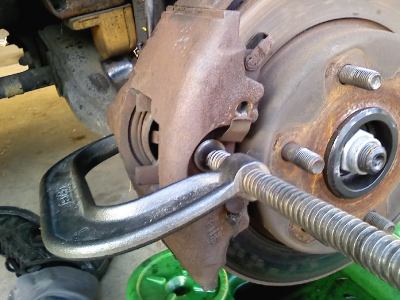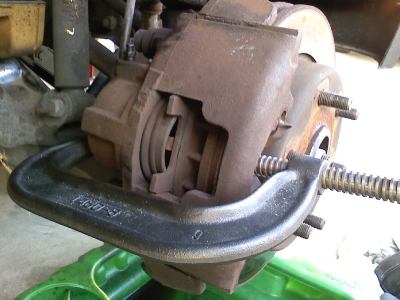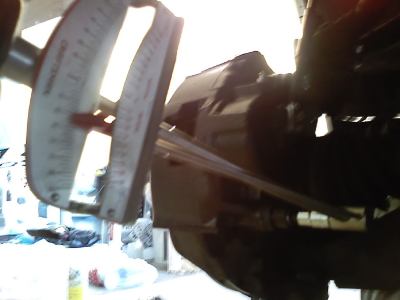ravingmadman
Chief Knuckle Buster
Loosen the lugs, then jack the wheel off the ground, then remove the tire. Use a long handled screw driver at this point to pry between the piston and the back of the inner brake pad to push the piston back into the caliper. You might want to monitor your brake fluid level, as it will probably overflow, but I usually just let it drip through to the ground, no harm no foul. Pushing the piston back is a real PITA to do later, and also helps get the inner pad loose at this point.
Loosen the two hex bolts on the inside of the caliper holding the caliper to the spindle, and remove the caliper. The inner pad should just about fall off- let it. To remove the outer pad, use a smaller screwdriver and pry it off. There is a piece of metal on the pad, with two bumps on it, and two detents on the caliper that the bumps fit into. You might have to use another screwdriver to help the bumps clear the detents, and slide the outer pad off.
Take the disc to your nearest Schuck's, and have them turned. It is $15 per disc, and gets rid of all pulsing, wobble, etc. Or you can buy new discs.
Make sure you apply a liberal coat of anti-squeak to the back of both brake pads. I just take my finger and smear it everywhere, but make sure you don't get any on the actual brake surface that pushes against the disc. The inner pad just snaps into place with a little bit of wiggling. The outer pad needs help to get the metal keeper with the bumps back into the detents. I usually tap it with the rubber handle of my screwdriver after it is in, to make sure it is really seated where it wants to be.
Put the disc back on. Lube the two hex bolts with lots of brake lube, and slide the caliper on (you'll find out now if you pushed your piston back in far enough at this point- beer is a good thing to have handy) and tighten the two hex bolts. Put the tire back on, hand-tighten the lugs, lower the wheel, tighten the lugs, and do the other side.
You'll need to pump the brakes a little to get the pistons back into position. When you first take off for a drive, your brakes will feel very soft at first, but they'll firm up after a couple hundred miles as the pads wear in. I usually do a couple laps in the parking lot, and do some really light braking (10-0 three or four times slowly), then harder braking (15-0 three or four times like I mean it), then finally a good 45-0 hard stop. Make sure if something lets go, or if a pad spalls/blows up, you've got a good hold on the wheel.
I also recommend keeping about a week's commuting between doing the front and rear brakes, so the front pads are good when you do the rear just in case. Brakes are important. Best of luck!!!

Loosen the two hex bolts on the inside of the caliper holding the caliper to the spindle, and remove the caliper. The inner pad should just about fall off- let it. To remove the outer pad, use a smaller screwdriver and pry it off. There is a piece of metal on the pad, with two bumps on it, and two detents on the caliper that the bumps fit into. You might have to use another screwdriver to help the bumps clear the detents, and slide the outer pad off.
Take the disc to your nearest Schuck's, and have them turned. It is $15 per disc, and gets rid of all pulsing, wobble, etc. Or you can buy new discs.
Make sure you apply a liberal coat of anti-squeak to the back of both brake pads. I just take my finger and smear it everywhere, but make sure you don't get any on the actual brake surface that pushes against the disc. The inner pad just snaps into place with a little bit of wiggling. The outer pad needs help to get the metal keeper with the bumps back into the detents. I usually tap it with the rubber handle of my screwdriver after it is in, to make sure it is really seated where it wants to be.
Put the disc back on. Lube the two hex bolts with lots of brake lube, and slide the caliper on (you'll find out now if you pushed your piston back in far enough at this point- beer is a good thing to have handy) and tighten the two hex bolts. Put the tire back on, hand-tighten the lugs, lower the wheel, tighten the lugs, and do the other side.
You'll need to pump the brakes a little to get the pistons back into position. When you first take off for a drive, your brakes will feel very soft at first, but they'll firm up after a couple hundred miles as the pads wear in. I usually do a couple laps in the parking lot, and do some really light braking (10-0 three or four times slowly), then harder braking (15-0 three or four times like I mean it), then finally a good 45-0 hard stop. Make sure if something lets go, or if a pad spalls/blows up, you've got a good hold on the wheel.
I also recommend keeping about a week's commuting between doing the front and rear brakes, so the front pads are good when you do the rear just in case. Brakes are important. Best of luck!!!




